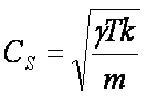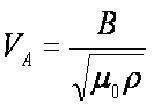Acoustic waves, or sound waves, are longitudinal waves that
need a material medium to propagate. Acoustic waves create pressure
gradients in the medium as they travel through it. In a plasma the speed of sound waves is

γ = ratio of specific heats in an ideal gas
T = temperature
k = Boltzmann’s constant
There are two types of magnetic
waves but they do not exist
independently of each other. Alfvén waves are transverse
magnetic waves that travel along a magnetic field line like a
wave travels along a plucked string. The speed of Alfvén waves is

B = magnetic field strength
μ = permeability constant
ρ = particle density
Magnetosonic waves are longitudinal magnetic waves that propagate
perpendicular to magnetic field lines. They create magnetic pressure
gradients as they travel across the magnetic field.
Usually we discuss electromagnetic (EM) waves by describing
the oscillating electric field. But we know that EM waves also
have a magnetic field that oscillates perpendicular
to the electric field.
So, if Alfvén and magnetosonic waves are magnetic waves, it's probably not surprising that they have an electric field
that oscillates perpendicular to the magnetic wave. This is one
mechanism that allows magnetic waves to drive acoustic waves.
Here is a diagram of how this might happen: It is described below.
As a magnetic wave propagates through a plasma, the
electric field creates pressure gradients in the plasma
(i.e. in the “gelatin”). These pressure gradients
in the gas of the plasma oscillate and are therefore acoustic
waves.
Another possible mechanism involves the velocity pertubations
to the magnetic field. Magnetic field perturbations are also
perturbations to the gas because this wave is in a plasma and
the gas moves with the magnetic
field. In both cases, when the wave is in a ß~1 plasma, the perturbations
to the gas cause oscillating pressure gradients that can decouple from the magnetic field and continue
to exist and propagate as acoustic
waves.
Next: Does ß=1 anywhere in
Earth’s atmosphere?
How are aurorae created?
Can we hear the aurorae?
Wave transformation on
the Sun
What is ß?
How can a magnetic wave
transform into an acoustic wave?
Does ß=1 anywhere in Earth’s
atmosphere?
Continuing research
Bibliography
